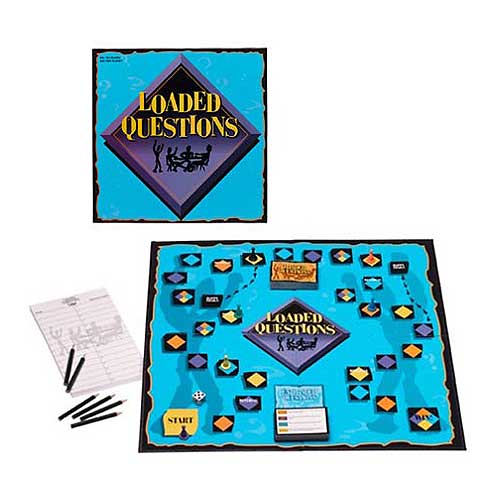
Once the roller has read the appropriate question, all other players write their answers on a piece of paper, and one player reads the answers to the roller, who assigns answer writers for each response. The board is made up of spaces of four colors: orange, purple, blue, and yellow, which correspond to questions of the categories "Hypotheticals," "Anything Goes," "No-Brainers," and "Personals," respectively. Once a player has moved the number of spaces indicated by the dice roll, the player draws a card and asks the question corresponding to the color that the player landed on. Players traverse the board with dice rolls, and each turn, they have the opportunity to win bonus moves. Players try to be the first person to move from the "START" square to the "WIN!" square. Poses said his game is "very simple" compared to strategy games, as in Loaded Questions "you get through the instructions in about three minutes." He said the game "tests players on how well they know each other." Recommend 4-6 players (but can be played with fewer or more players) We will look at how this can be used maliciously later on, but for now, let’s look at an example that you’re probably familiar with.Loaded Questions is a question-based board game created by Eric Poses in 1996. Loaded questions help people gain control by tricking others into implying something about themselves that isn’t true–and often unfavorable.

How are loaded questions used to gain control? These questions are often inflammatory in nature, making them an effective way to derail an otherwise rational debate, as the recipient may be quick to become defensive. Often, especially in debates, the assumption being made is controversial or notably untrue. How are loaded questions used in a debate?

“Are you one of those hateful people that doesn’t have any religious beliefs?”įor example, if you try to answer the question ‘ Do you agree with the view that steady GDP growth and low inflation have left the Indian economy in good shape?’ with either yes or no, you are just focussing on the current shape of the economy. What happens when you answer no to a loaded question?Īccordingly, if the respondent believes that that person is innocent and replies “no”, in order to show that they don’t think a conviction is necessary, then their answer will inadvertently suggest that they believe that person is in fact a criminal. What are your favorite songs from your teenage years that you still rock out to when nobody else is listening?.Who is your favorite cartoon character?.How long would you last in a zombie apocalypse?.Some questions aren’t related to anything we’ve done in class, but probably reflect a musical experience that the question writer had outside of school. The question board allows students to ask questions that are unrelated to the current lesson or unit. Derived from the famous line in William Shakespeare’s Hamlet, “To be, or not to be, that is the question.” Usually used humorously, especially as a rhyming pun on “be.” To tell Jake or not to tell him.

Used to express one’s indecision or hesitation about doing something. Only when some of these presuppositions are not necessarily agreed to by the person who is asked the question does the argument containing them become fallacious. Other players write what they expect the roller to write, and then all non-rolling players read their answers.Ī loaded question is a form of complex question that contains a controversial assumption (e.g., a presumption of guilt).

For a Reversal, the roller records an answer to the appropriate question, while all other players must anticipate the roller’s response.


 0 kommentar(er)
0 kommentar(er)
